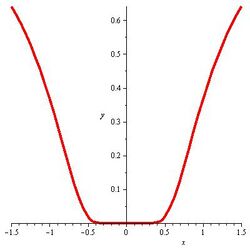Flat function

In mathematics, especially real analysis, a real function is flat at if all its derivatives at exist and equal 0.
A function that is flat at is not analytic at unless it is constant in a neighbourhood of (since an analytic function must equals the sum of its Taylor series).
An example of a flat function at 0 is the function such that and for
The function need not be flat at just one point. Trivially, constant functions on are flat everywhere. But there are also other, less trivial, examples; for example, the function such that for and for
Example
The function defined by
is flat at . Thus, this is an example of a non-analytic smooth function. The pathological nature of this example is partially illuminated by the fact that its extension to the complex numbers is, in fact, not differentiable.
References
- Glaister, P. (December 1991), A Flat Function with Some Interesting Properties and an Application, The Mathematical Gazette, Vol. 75, No. 474, pp. 438–440
 |

